Building a successful email marketing strategy isn’t just about crafting catchy subject lines or designing beautiful emails. At the heart of it all lies key ingredients: trust and credibility. To build trust and credibility with email marketing is what you must do to make subscribers trust you before they can open, read, and click through your emails, not to mention stick around for a long time. But without trust, your messages might end up ignored or, worse, in the spam folder.
People receive at least 121 emails per day. The business emails that get opened are the ones that build genuine, reliable relationships with their audience. Think of it like a friendship if you keep your word, respect boundaries, and offer value, people will come to trust and rely on you.
But how do you create that kind of relationship with email? In this post, we’ll explore tried-and-true tips and techniques for building trust and credibility with your subscribers. From setting clear expectations and delivering personalized content to respecting privacy and encouraging two-way communication, these strategies will help you foster lasting relationships through email.
Why Trust Matters in Email Marketing
Trust isn’t just a buzzword; it’s the backbone of effective email marketing. If you receive emails from two brands. One regularly delivers exactly what you signed up for valuable tips, special offers, and honest updates. The other is unpredictable, maybe sending content that doesn’t relate to your interests or pushing hard-to-believe offers. Which one would you open and engage with more often?
Trust shapes how your subscribers feel about your business and drive every interaction with your emails. When subscribers trust you, they’re not just readers; they’re partners in your journey. They look forward to your emails, engage with your offers, and are more likely to click your call to action button.
Building trust means building a relationship, which keeps your audience coming back. Studies have shown that trust directly impacts email key metrics like open, click-through, and conversion rates. People engage more with brands they trust and feel connected with.
However, trust doesn’t come easy and it can be lost quickly. A single misleading subject line or one too many overly promotional emails can corrupt the trust you’ve worked hard to build. And once it’s gone, it’s a steep climb to get it back.
Here’s what trust brings to the table in email marketing:
- Higher Engagement Rates: Subscribers who trust you will open your emails, click on links, and interact with your content.
- Long-Term Loyalty: Trust builds customer loyalty. When subscribers feel valued, they’re more likely to stay subscribed and even recommend your brand to others.
- Reduced Unsubscribe Rates: Trustworthy content gives subscribers fewer reasons to opt out. Instead of feeling bombarded, they feel appreciated and connected.
Email marketing without trust is like shouting into the deep black forest, no one is listening. When subscribers know they can rely on you to deliver value, you’re no longer just another message in their inbox you’re a brand they care about and that’s when your email marketing begins to work.
11 Ways to Build Trust and Credibility with Email Marketing
Building trust and credibility with your email audience is the secret to successful email marketing. People are more likely to open, read, and engage with emails from senders they trust.
But trust isn’t handed out freely, it’s earned through consistency, value, and authenticity. Below are the ways to help you foster that trust and establish your credibility, turning your emails into a go-to resource your audience looks forward to.
- Understand Your Audience’s Needs
One of the ways to build trust and credibility with email marketing is to understand your audience’s needs. When you understand your audience’s needs and tailor your messages to match, your emails become less of an intrusion and more of a welcome conversation.
Getting to know your audience is the first step in building trust. It’s not about guessing what they like, you need to learn directly from their actions and preferences. Every subscriber is unique, and putting them all into a single category can spell doom for your marketing efforts.
Instead, start with some basics like segmentation and personalization. Segmenting your email list allows you to deliver more relevant content based on age, location, interests, or past interactions.
For instance, let’s say you’re a fitness brand. A subscriber interested in weight loss may want tips on low-calorie recipes, while someone focused on muscle gain might prefer strength training routines. When your emails reflect each group’s unique goals, you’re not just selling; you’re supporting their journey.
Tips for Understanding Your Audience
- Use Surveys and Polls: Don’t be afraid to ask directly. A quick survey in a welcome email or a poll in a newsletter can give you valuable insights into what your subscribers are looking for.
- Track Engagement Metrics: Pay attention to open rates, click-throughs, and unsubscribes. These metrics can reveal what topics, products, or tones resonate most (or least) with your audience.
- Encourage Feedback: Include a call-to-action in some of your emails inviting subscribers to reply with their thoughts or suggestions. Simple questions like, “What topics would you like us to cover?” or “How can we make our emails better for you?” go a long way.
When you understand your audience’s needs, you’re able to create emails that speak directly to them. This makes subscribers feel valued and understood, which is the foundation of trust. And as trust grows, so does engagement, loyalty, and, ultimately, the success of your email marketing efforts.
- Set Clear Expectations from the Start
The relationship between you and your subscribers starts when they hit the “subscribe” button. What happens next determines whether they’ll stay engaged or unsubscribe from your list. Setting clear expectations right from the beginning isn’t just polite, it’s an essential tool to build trust and credibility with email marketing. When subscribers know what to expect from your emails, they’re more likely to stay engaged and feel confident in your brand.
If someone signs up for weekly tips on productivity on your website but keeps receiving daily promotions, it will not be long before they lose interest in your email or mark them as spam.
Clarity at the outset helps subscribers feel in control and reassures them that they’re getting what they signed up for.
Here’s how to set those clear expectations from day one:
- Define the Content They’ll Receive
In your sign-up form or welcome email, let subscribers know the types of content you will be sending might be industry tips, special discounts, product updates, or event invitations. This way, they will know exactly what’s coming and why it’s valuable, when subscribers see the value upfront, they’re more likely to stick around.
- Specify the Frequency
Frequency is a big factor in maintaining trust; being upfront about how often they will receive emails from you, will help them decide if they want to hear from you weekly, bi-weekly, or monthly.
- Send a Welcome Email
A warm welcome email reinforces everything you’ve promised. Use it to thank them for joining, remind them what they’ll receive, and even give a sneak peek of what’s coming. This simple step shows that you’re intentional and respect their time inbox. Here is an excerpt from the first email (welcome email) we send out to people who subscribe to our mailing list.
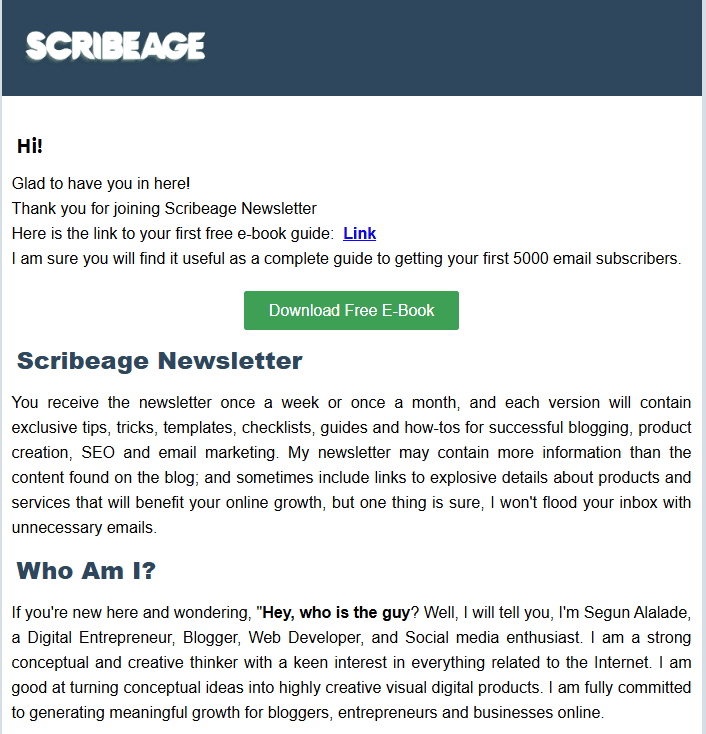
Subscribers know exactly what they’re signing up for, and they’re more likely to trust you with their inbox and attention over the long term. If you respect their preferences and follow through on your promises, you’re well on your way to building a loyal, engaged audience.
- Personalize Your Content for Real Connections
No one wants to feel like just another name on a mailing list; personalization in email marketing is the key to making each subscriber feel seen and valued, and turning your messages into genuine and impactful interactions.
Personalization goes beyond simply adding a first name to the greeting; it’s about delivering content that aligns with each subscriber’s unique interests, behaviours, and needs. and help you build trust and credibility with your email marketing campaigns.
Here are a few ways to create more personalized and trust-building email content:
- Segment Your Audience by Interests
Not every subscriber is interested in the same products, topics, or services. Segmenting your audience into groups based on their preferences such as purchases, clicked links, or browsing history will allow you to deliver highly relevant content to each segment. At Scribeage, we use Mautic for our email and marketing automation and here is a part of our email segmentation.
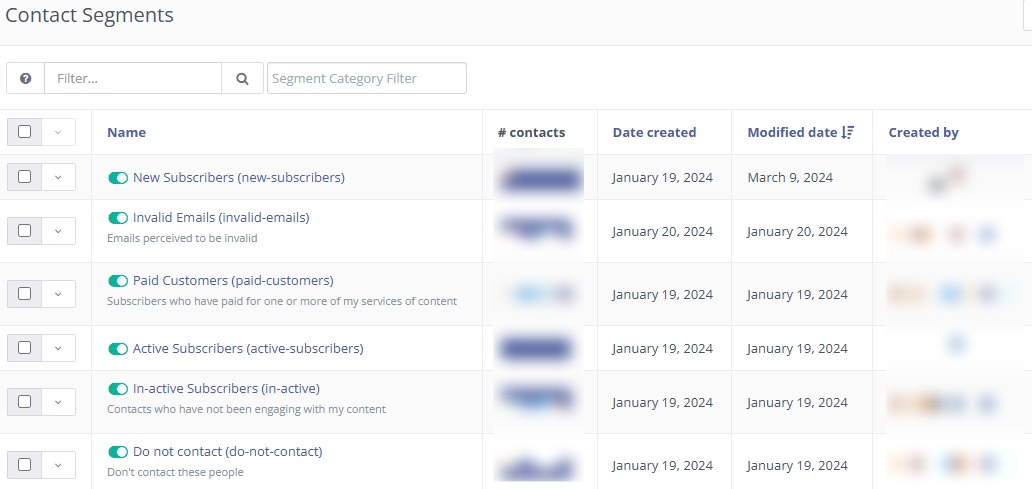
Segmenting your email list based on set criteria will help you send emails based on what your reader wants and in return build trust and credibility with email marketing.
- Use Dynamic Content Blocks
Dynamic content blocks allow you to display different content within the same email, depending on the recipient’s profile. This might mean showcasing region-specific events, tailoring product recommendations, or offering content in a language that matches the subscriber’s location. Dynamic content makes each email feel customized without creating separate campaigns for each audience.
- Consider Timing and Frequency
Personalization isn’t only about what’s in the email; it’s also about when you send it. By tracking engagement patterns, you can adjust email frequency and timing to better match each subscriber’s habits. If certain subscribers engage more on weekends, you can schedule their emails accordingly. This small adjustment shows you’re paying attention and respecting their preferences.
- Ask for Feedback and Use It
A quick survey or poll can reveal what subscribers truly want, and implementing their feedback is the ultimate form of personalization. Ask them about topics they’re interested in or the offers they’d like to receive. Incorporating their input doesn’t just enhance engagement it also shows that you’re listening and genuinely care about their experience.
- Provide Valuable Content Consistently
As we all know, trust isn’t what you can build in a day it’s earned over time, and delivering valuable, consistent content is how you keep it. Subscribers sign up with the expectation that your emails will bring something useful to their lives, whether it’s a tip, exclusive offer, or insightful article.
If your content is all over the place or doesn’t provide real value, your subscribers can tune out or, worse, unsubscribe from your list. Providing consistent, valuable content is like building a steady bridge between you and your audience.
Here’s how to provide valuable and consistent content that keeps your audience engaged and loyal:
- Stick to Your Core Topics
Know what your audience cares about and stay focused on it. If you’re a digital marketing agency, your emails should revolve around SEO tips, social media strategies, or content marketing advice not unrelated topics like fashion or personal finance.
When you stay within your audience’s interests, you build authority and trust, proving you’re a go-to source for reliable information in your niche.
- Maintain a Consistent Schedule
Being predictable in timing makes your emails something your audience can rely on. For instance, if you send a weekly newsletter every Tuesday, your subscribers will come to expect (and look forward to) that Tuesday email.
This consistency can signal dependability, reassuring subscribers that your content will always be there to add value not randomly clutter their inboxes.
- Balance Promotion with Information
While promoting products or services is a part of email marketing, overdoing it can break trust. Aim for a balance between promotional and informative, actionable content that benefits your readers without expecting a sale.
For example, if you sell SAAS software, you can mix product updates with helpful articles like “5 Tips to Boost Productivity” or “How to Maximize Efficiency with your Product.”
- Educate, Entertain, or Solve Problems
Valuable content usually fits one (or more) of these categories: it educates, entertains, or solves a problem. Whether it’s an insightful guide, a fun quiz, or an exclusive offer, ensure each email offers something your audience can use or enjoy. In the image below, Kit formerly ConverKit sent an email to help their customers build incredible lead magnets that will grow their lists.
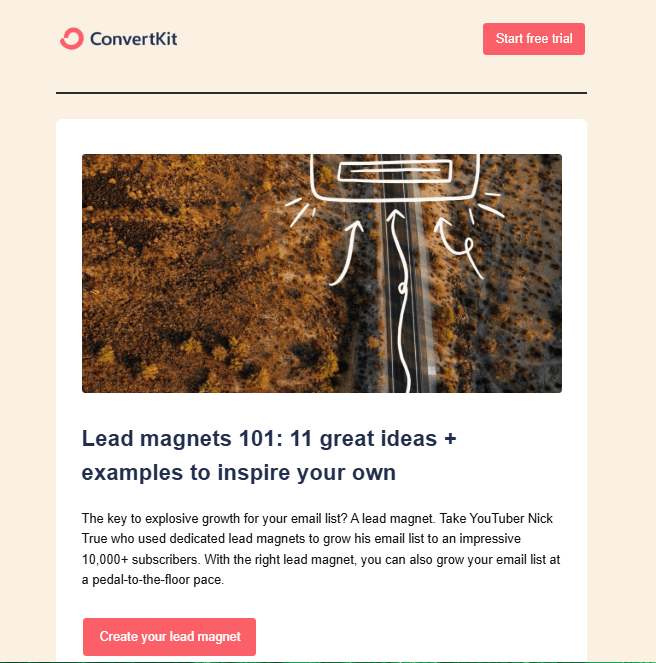
- Add Personal Insights or Stories
People connect with people, not faceless companies. Adding a personal story, a lesson you learned, or a behind-the-scenes peek adds personality to your emails.
- Craft Honest and Transparent Subject Lines
The subject line is the first impression of your email, it’s the virtual knock on the door that determines whether subscribers let you in or ignore you. To build trust and credibility with email marketing efforts, you need to work on creating an honest and transparent subject line
In a sea of promotional emails and clickbait headlines, honest and transparent subject lines will stand your email out and set the tone for a trustworthy relationship. When you deliver on what you promise in the subject line, you’re proving to subscribers that your word matters.
If people open an email with a subject line promising “50% Off Today Only!” only to find out the discount only applies to select items or comes with a bunch of conditions. They will feel disappointed and that can damage their trust in you. Below is an example of an honest subject line by the Sender email marketing platform, short with clear intention.

Honest subject lines keep expectations clear and ensure your subscribers feel valued, not tricked.
Here’s how to craft subject lines that build trust and drive open rates without the bait-and-switch:
- Be Direct and Descriptive
Instead of hyping up a vague offer, let subscribers know exactly what’s inside the email. If you’re sharing tips on productivity, a subject line like “5 Simple Productivity Tips You Can Start Today” is clear, actionable, and enticing. Transparency about what’s inside builds anticipation without overpromising.
- Avoid Misleading Clickbait
Clickbait might get a few extra opens in the short term, but it’s a quick way to lose trust. Subject lines like “You Won’t Believe This Offer!” might create curiosity, but they often lead to disappointment. Subscribers will quickly learn to tune out or mistrust your emails if they feel misled.
- Create Urgency Without False Pressure
Urgency can encourage immediate action, but there’s a fine line between genuine urgency and pressure tactics. If an offer expires soon, mention it, but only if it’s true. Avoid subject lines like “Final Offer Today!” when it’s not the final offer this can lead to scepticism.
- Include Personalization When Possible
Personalizing the subject line with a subscriber’s name, location, or recent activity can make it feel more relevant. For example, “Jane, Here’s Your Exclusive Guide to SEO” feels personal and direct.
- Respect Subscribers’ Privacy and Data Security
Every time someone joins your email list, they’re handing over a piece of their personal information and trusting you to handle it responsibly. If you want to build trust and credibility with email marketing and subscribers to stay with you, respect their privacy and ensure their data security.
Here’s how to show your subscribers that their privacy and security are in good hands:
- Be Transparent About Data Collection and Use
Right from the start, make it clear how you’ll use their information. In your sign-up forms and welcome emails, let subscribers know what type of content they can expect, how often they’ll hear from you, and that their information is safe.
Transparency around data usage builds confidence and ensures that subscribers don’t feel blindsided by unexpected uses of their personal information.
- Comply with Privacy Laws
Privacy laws like GDPR (General Data Protection Regulation) and CAN-SPAM aren’t just legal requirements they’re standards of trustworthiness.
Ensure your email marketing complies with these laws by including an easy unsubscribe option, obtaining clear consent, and giving subscribers control over their data.
- Avoid Sharing Subscriber Data with Third Parties
Sharing or selling your subscriber data without explicit permission is a fast way to lose trust. If you work with third-party vendors (like email service providers), make sure they follow stringent data protection practices.
Also, if you ever plan to share data with a partner, inform your subscribers and give them the choice to opt out.
- Practice Secure Data Storage
Storing subscriber data securely is critical for building a trustworthy brand. Use reputable email marketing platforms such as Sender, MailerLite, Moosend, and HubSpot that offer encryption and other security measures to protect your subscriber data.
- Limit the Data You Collect
Collect only the information you need. If someone is signing up for a newsletter, for example, their name and email should usually be enough. Asking for excessive details can feel intrusive and make subscribers think twice about joining. The simpler your sign-up process and data requests, the more comfortable people will feel entrusting you with their information.
- Build Trust with Secure Payment Processing
If you’re running an eCommerce business, ensure that any payment-related emails use secure, encrypted links and that you’re partnering with reliable, secure payment processors.
- Avoid Over-Promotion
At one point or the other, we all had signed up for a newsletter that seemed helpful at first, only to find our inbox flooded with sales pitches and promotional emails.
It’s overwhelming and more often than not, leads to an unsubscribe click.
To avoid turning subscribers away, follow the 80/20 rule: make 80% of your email content valuable, informative, or entertaining, and keep only 20% of it focused on promotion.

This balance shows subscribers that you’re more interested in helping them than just making a sale.
Here’s how to nail that balance and build loyalty:
- Focus on Educational and Entertaining Content
Keep the bulk of your emails geared toward helping or delighting your readers. Think tutorials, quick tips, industry insights, or helpful resources. When you focus on their interests, your subscribers start seeing your emails as a valuable resource.
- Only Promote When There’s Real Value
Reserve your promotional efforts for times when there’s genuine value for the reader like a limited-time sale, a new product launch, or an exclusive discount.
This keeps promotions feeling special rather than spammy. If your audience knows you’ll only promote something when it’s worthwhile, they’re more likely to trust your offers and take action.
- Integrate Subtle CTAs Within Value-Driven Content
If you need to weave in a promotional aspect, try doing it within educational content. For example, if you’re sharing a blog post with tips for beginners, you might include a mention of a product that can help them, with a link at the end. This way, you’re not hard-selling; instead, you’re gently guiding them toward a solution they may need.
- Encourage Feedback and Interaction
Make your emails a two-way conversation by asking questions, encouraging replies, or linking to surveys. This helps you understand what content your subscribers value most and shows them you’re listening.
- Be Consistent and Reliable
Just like in any relationship, trust in email marketing is built on consistency and reliability. When your subscribers know they can count on you to show up when you say you will, with content that’s relevant and valuable, you’re laying a strong foundation for loyalty.
Here’s how to stay consistent and reliable in your email marketing efforts:
- Stick to a Predictable Schedule
People enjoy routines they like knowing that they’ll get your newsletter on the same day each week or month. Set a regular schedule, whether it’s weekly, bi-weekly, or monthly, and stick to it. This shows subscribers that you’re committed to providing value and helps your emails become a welcome habit in their inboxes.
- Deliver What You Promise
If your sign-up form says subscribers will get “weekly tips” or “exclusive monthly discounts,” make sure that’s exactly what they receive. Delivering on your promises not only builds credibility but also ensures your audience stays interested.
- Maintain a Consistent Tone and Branding
Your subscribers should feel a sense of familiarity each time they open your email. Consistency in tone, design, and branding creates a cohesive experience that subscribers recognize and trust.
Whether your brand voice is casual, professional, or humorous, stick to it. Consistency in these details helps you establish a recognizable presence and strengthens your brand identity.
- Be Reliable in the Quality of Content
When your emails are reliably informative, insightful, or entertaining, subscribers are more likely to open and engage. Avoid sending “filler” emails or content that feels thrown together just to meet a deadline; your audience can tell when content lacks effort.
- Be Transparent About Changes
Life and business evolve, and sometimes you may need to adjust your email schedule, introduce new types of content, or change your frequency. If any changes are on the horizon, be transparent about them with your audience.
Letting subscribers know of any adjustments in advance shows respect for their time and reinforces that you’re committed to open communication.
- Encourage Two-Way Communication
While your messages might land in the inboxes of thousands, the best way to make your subscribers feel valued is by inviting them to respond. Encouraging your subscribers to respond to your email is another way to build trust and credibility with email marketing
Email marketing doesn’t have to be a one-way street; when you encourage two-way communication, you’re no longer just a “sender” in their inbox you become someone they can connect with, share feedback with, and build a relationship with.
Here’s how to foster two-way communication that builds rapport and trust:
- Ask for Feedback and Opinions
Invite your subscribers to share their thoughts, preferences, or questions. For instance, if you’re an online bookstore, you might ask, “What genres would you love to see more of in our recommendations?” This not only helps you tailor your content but also shows subscribers that their opinions matter.
- Include Interactive Elements
Polls, surveys, and quizzes are fun and easy ways to get subscribers involved. These can be short and sweet, such as a “Which tip was your favourite?” at the end of an email.
Your email engagement will go up when people feel involved, and it gives you valuable insights about what they’re enjoying.
- Invite Replies to Specific Questions
Encourage subscribers to reply by asking for feedback directly in your emails. For example, if you run a fitness brand, you could say, “What’s one thing you struggle with in your fitness routine? Hit reply and let us know!”
- Feature Subscriber Stories and Testimonials
Celebrate your subscribers by featuring their stories, testimonials, or responses in your emails, but with their permission. This gives readers a sense of community and shows that you care about their journeys.
- Use Automated Responses to Keep Engagement Flowing
If you’re using an auto-reply for new subscribers, craft a warm and personal welcome message that invites them to ask questions or share more about themselves. Little touches like, “We’re thrilled to have you here! Let us know what you’re most interested in learning!” set a friendly tone right from the start.
- Create Community Opportunities Outside of Email
If you’re up for it, encourage subscribers to join other community spaces, like a private Facebook group, Slack channel, or online forum. This way, they can connect with you and each other.
Having a place where subscribers can interact and share with others who share their interests strengthens your community and deepens their loyalty to your brand.
- Showcase Social Proof and Testimonials
People naturally trust others’ experiences, especially those who have had positive outcomes with a product or service. Social proof within your email isn’t just about saying, “Look, people like us!” It’s about creating a sense of community and showing your subscribers that they’re part of something valuable and trusted.
Another unique way to build trust and credibility with email marketing is to include social proof and testimonials from your satisfied customers in your emails. In the image below, Moosend includes clients’ testimonials to show how their platform is helping people solve their mailing problems.
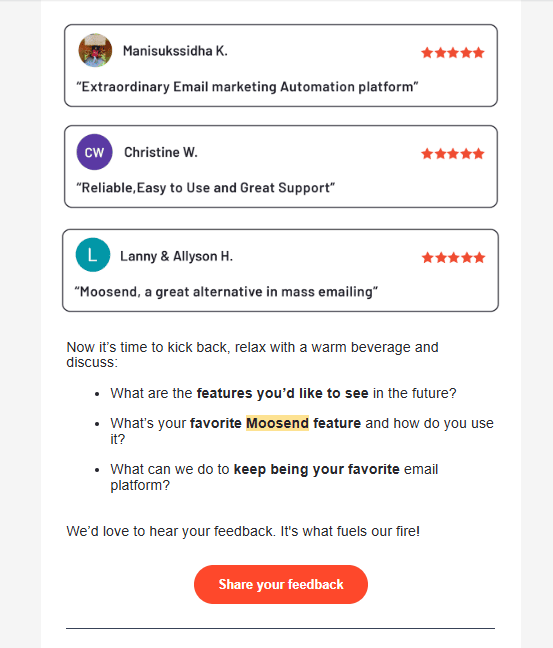
Here’s how to strategically include social proof and testimonials in your emails:
- Highlight Customer Success Stories
Sharing real stories of how your product or service has made a difference is incredibly impactful. For instance, if you offer an online course, you might showcase a story like, “Meet Sarah, who used our program to start her own side business in just three months.” Real stories are relatable and give subscribers a glimpse of what’s possible when they choose your brand.
- Feature Testimonials from Happy Customers
A few short quotes from satisfied customers can go a long way. When a potential customer reads about someone else’s positive experience, it builds confidence. Make sure the testimonials are specific, focusing on actual results or improvements rather than generic praise.
- Showcase Metrics and Results
Numbers don’t lie, and they’re a powerful form of social proof. If you have impressive statistics, such as “95% of our customers saw improvements within 30 days,” or “Trusted by over 10,000 entrepreneurs,” include them in your emails.
Metrics give subscribers quantifiable reasons to trust you, especially when paired with visual elements like graphs or charts to make the numbers more eye-catching.
- Use Case Studies and In-Depth Examples
If your product or service has unique use cases or ways it’s helped different industries, share these as mini-case studies. Explain the customer’s initial challenge, how they used your product to overcome it, and the results they achieved.
- Incorporate User-Generated Content (UGC)
User-generated content is a great way to highlight real customers using your product. Encourage subscribers to share photos, stories, or feedback that you can feature in your emails.
- Highlight Awards, Certifications, and Media Mentions
If your brand has received any awards, certifications, or media features, make sure to include them in your emails. Phrases like “As featured in Forbes” or “Awarded Best in Class 2024” immediately increase your credibility.
It shows subscribers that your brand has been recognized by reputable sources, which adds an extra layer of trust.
- Share Reviews from Third-Party Platforms
When possible, include snippets from third-party review platforms like Trustpilot, G2, or Yelp. Reviews on independent sites feel especially credible because they’re not controlled by you.
Link directly to these pages so subscribers can read more if they wish, this transparency builds even more trust.
- Monitor and Act on Engagement Metrics
Tracking email engagement isn’t just about counting opens and clicks; it’s a way of keeping your finger on the pulse of your audience’s preferences and interests. If you understand what’s working and what isn’t, you can make data-driven adjustments to build a better experience for your subscribers.
Let’s look at key metrics to monitor and actionable steps to keep your email strategy fresh and relevant.
- Open Rate: Gauge Initial Interest
Open rates give you a quick snapshot of how effective your subject lines are. If you notice a drop in open rates, it might signal that your subject lines aren’t capturing interest, or your emails are landing in promotions or spam folders.
- Click-Through Rate (CTR): Measure Content Engagement
Your CTR reveals whether readers find the content within your emails valuable enough to take action. If your CTR is low, you can refine your calls-to-action (CTAs) and make sure the content directly addresses subscriber needs.
- Bounce Rate: Ensure Deliverability
A high bounce rate can hurt your sender’s reputation and impact your ability to reach your subscribers’ inboxes. Hard bounces (permanent issues, like invalid email addresses) can often be reduced by periodically cleaning your list and removing inactive or unreachable addresses.
Soft bounces (temporary issues) may indicate an inbox is full or there’s a server issue, so keep an eye on these and adjust your re-send strategies if needed.
- Unsubscribe Rate
If unsubscribes start to increase, it might mean that your content isn’t aligned with what subscribers expect or need. This metric can offer a reality check to know when to rethink your approach.
- Conversion Rate: Assess Campaign Effectiveness
For campaigns with a specific goal, such as a product sale or webinar registration, your conversion rate tells you how effective your email was in driving action. A low conversion rate could mean that while people are engaging with your content, they’re not finding enough value to convert.
Experiment with your messaging, incentives, and landing page experience to see what drives the most conversions.
- Spam Complaints
High spam complaints can harm your sender’s reputation and send future emails straight to spam. If you notice an increase in complaints, it’s a signal that your content or frequency may be irritating some subscribers. Be mindful of how often you send emails, and ensure each message provides value.
- Device and Location Insights
If you notice that a large percentage of your audience opens emails on mobile, optimize your design and layout for mobile-first. Location data can also help you personalize content for different time zones or tailor offers that are geographically relevant.
- Heatmaps and Scroll Tracking
Heatmaps show you where subscribers click most, and scroll tracking reveals how far they’re reading into your emails. This insight helps you position key elements like CTAs or discounts where they’ll be most visible.
If your readers aren’t scrolling down, try shorter emails or moving critical information higher up in your content.
Building Trust is an Ongoing Commitment
Building trust with your audience through email marketing isn’t a one-and-done effort. It’s a continual journey that requires dedication, transparency, and a commitment to delivering value.
Focusing on understanding your audience, personalizing your content, maintaining transparency, and using ethical practices like respecting privacy and avoiding over-promotion, can help you create long-lasting relationships with your subscribers.
It’s all about creating an experience that respects your subscribers as individuals, understanding their needs, and being there for them in a way that’s both useful and relevant.
When your audience feels valued, their trust in you grows, making them more likely to open your emails, click on your offers, and ultimately convert into loyal customers.
As you move forward with your email marketing efforts, remember that trust isn’t something you can demand; it’s something you earn through every interaction.
Stay patient, stay consistent, and keep refining your approach. Over time, your audience will respond with increased engagement, loyalty, and advocacy for your brand.
Take action don’t just read these tips and nod along, implement them today, and watch how your email marketing transforms from transactional to relational. Trust is the foundation of successful email campaigns, and with the right strategies, you’ll build it, one email at a time.



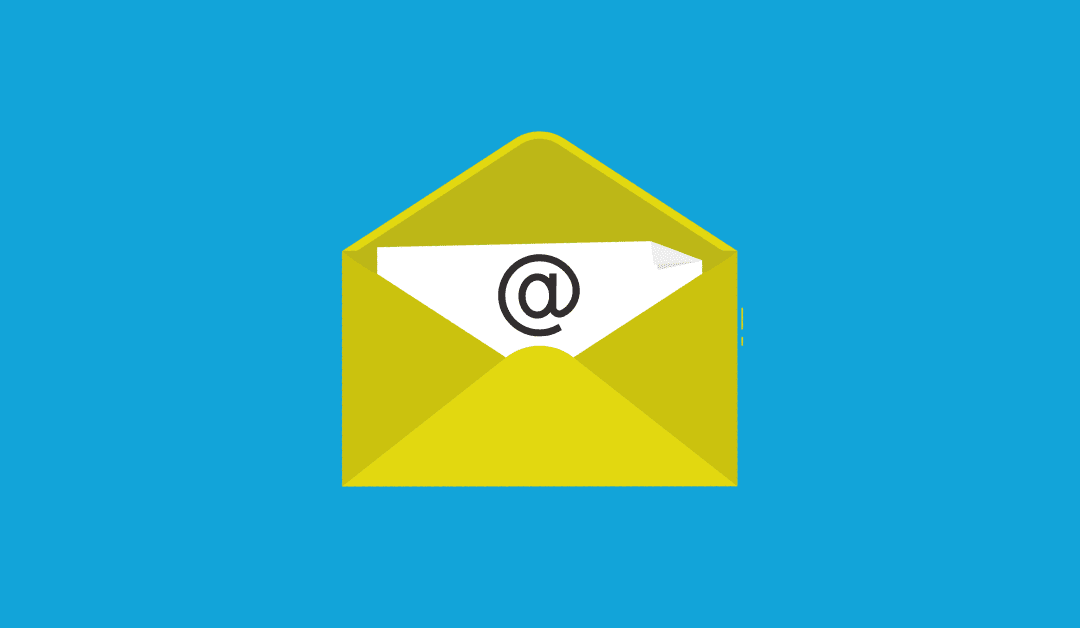

0 Comments